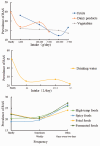Relationship between dietary factors and recurrent aphthous stomatitis in China: a cross-sectional study
- PMID: 34057842
- PMCID: PMC8753793
- DOI: 10.1177/03000605211017724
Relationship between dietary factors and recurrent aphthous stomatitis in China: a cross-sectional study
Abstract
Objective: Recurrent aphthous stomatitis (RAS), a common oral mucosal disorder characterized by chronic, inflammatory, and ovoid ulcers, has a complex etiology. The purpose of the study was to investigate the specific dietary factors influencing the prevalence of RAS.
Methods: A total of 754 participants aged 18 to 59 years were enrolled in this descriptive cross-sectional study. An anonymous questionnaire was adopted to investigate the distribution of RAS, dietary factors, self-reported trigger factors, and therapeutic methods.
Results: Among all participants, the prevalence rate of RAS was 21.4%. Univariable analysis showed that fruit, dairy products, vegetables, and water, but not fried foods, fermented foods, spicy foods, and eggs, were preventive factors against RAS. After adjusting for age and sex, multivariable regression analysis suggested that fruit (adjusted odds ratio [aOR] = 0.430, 95% confidence interval [CI] = 0.218-0.847) and water (aOR = 0.294, 95% CI = 0.119-0.726) were protective factors against RAS.
Conclusion: This study found that the consumption of fruit and water was negatively associated with RAS. These results imply a potential adjunctive and complementary role of food in RAS treatment and some feasible means of RAS prevention.
Keywords: Recurrent aphthous stomatitis; cross-sectional study; dietary habit; prevalence; preventive factor; treatment.
Conflict of interest statement
Figures



References
-
- Yasui K, Kurata T, Yashiro M, et al.. The effect of ascorbate on minor recurrent aphthous stomatitis. Acta Paediatr 2010; 99: 442–445. DOI: 10.1111/j.1651-2227.2009.01628.x. - PubMed
-
- Giannetti L, Murri Dello Diago A, Lo Muzio L. . Recurrent aphtous stomatitis. Minerva Stomatol 2018; 67: 125–128. DOI: 10.23736/s0026-4970.18.04137-7. - PubMed
-
- Bilodeau EA, Lalla RV. Recurrent oral ulceration: Etiology, classification, management, and diagnostic algorithm. Periodontol 2000 2019; 80: 49–60. DOI: 10.1111/prd.12262. - PubMed
-
- Chiang CP, Yu-Fong Chang J, Wang YP, et al.. Recurrent aphthous stomatitis - Etiology, serum autoantibodies, anemia, hematinic deficiencies, and management. J Formos Med Assoc 2019; 118: 1279–1289. DOI: 10.1016/j.jfma.2018.10.023. - PubMed
MeSH terms
LinkOut - more resources
Full Text Sources
Medical

